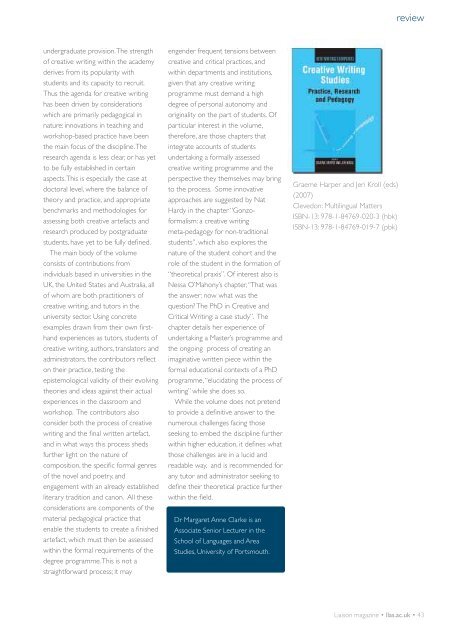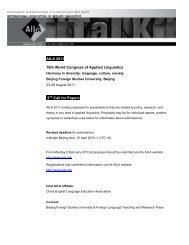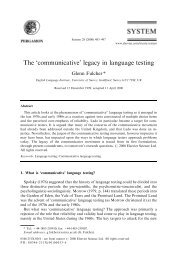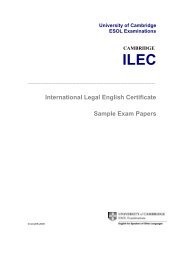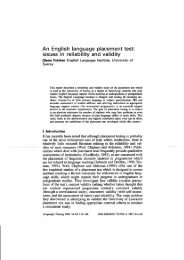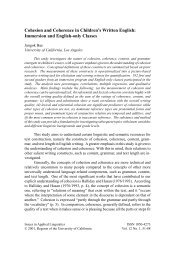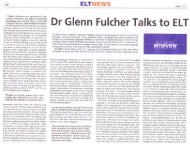Liaison Magazine - LLAS Centre for Languages, Linguistics and ...
Liaison Magazine - LLAS Centre for Languages, Linguistics and ...
Liaison Magazine - LLAS Centre for Languages, Linguistics and ...
Create successful ePaper yourself
Turn your PDF publications into a flip-book with our unique Google optimized e-Paper software.
eview<br />
undergraduate provision.The strength<br />
of creative writing within the academy<br />
derives from its popularity with<br />
students <strong>and</strong> its capacity to recruit.<br />
Thus the agenda <strong>for</strong> creative writing<br />
has been driven by considerations<br />
which are primarily pedagogical in<br />
nature: innovations in teaching <strong>and</strong><br />
workshop-based practice have been<br />
the main focus of the discipline.The<br />
research agenda is less clear, or has yet<br />
to be fully established in certain<br />
aspects.This is especially the case at<br />
doctoral level, where the balance of<br />
theory <strong>and</strong> practice, <strong>and</strong> appropriate<br />
benchmarks <strong>and</strong> methodologies <strong>for</strong><br />
assessing both creative artefacts <strong>and</strong><br />
research produced by postgraduate<br />
students, have yet to be fully defined.<br />
The main body of the volume<br />
consists of contributions from<br />
individuals based in universities in the<br />
UK, the United States <strong>and</strong> Australia, all<br />
of whom are both practitioners of<br />
creative writing, <strong>and</strong> tutors in the<br />
university sector. Using concrete<br />
examples drawn from their own firsth<strong>and</strong><br />
experiences as tutors, students of<br />
creative writing, authors, translators <strong>and</strong><br />
administrators, the contributors reflect<br />
on their practice, testing the<br />
epistemological validity of their evolving<br />
theories <strong>and</strong> ideas against their actual<br />
experiences in the classroom <strong>and</strong><br />
workshop. The contributors also<br />
consider both the process of creative<br />
writing <strong>and</strong> the final written artefact,<br />
<strong>and</strong> in what ways this process sheds<br />
further light on the nature of<br />
composition, the specific <strong>for</strong>mal genres<br />
of the novel <strong>and</strong> poetry, <strong>and</strong><br />
engagement with an already established<br />
literary tradition <strong>and</strong> canon. All these<br />
considerations are components of the<br />
material pedagogical practice that<br />
enable the students to create a finished<br />
artefact, which must then be assessed<br />
within the <strong>for</strong>mal requirements of the<br />
degree programme.This is not a<br />
straight<strong>for</strong>ward process; it may<br />
engender frequent tensions between<br />
creative <strong>and</strong> critical practices, <strong>and</strong><br />
within departments <strong>and</strong> institutions,<br />
given that any creative writing<br />
programme must dem<strong>and</strong> a high<br />
degree of personal autonomy <strong>and</strong><br />
originality on the part of students. Of<br />
particular interest in the volume,<br />
there<strong>for</strong>e, are those chapters that<br />
integrate accounts of students<br />
undertaking a <strong>for</strong>mally assessed<br />
creative writing programme <strong>and</strong> the<br />
perspective they themselves may bring<br />
to the process. Some innovative<br />
approaches are suggested by Nat<br />
Hardy in the chapter “Gonzo<strong>for</strong>malism:<br />
a creative writing<br />
meta-pedagogy <strong>for</strong> non-traditional<br />
students”, which also explores the<br />
nature of the student cohort <strong>and</strong> the<br />
role of the student in the <strong>for</strong>mation of<br />
“theoretical praxis”. Of interest also is<br />
Nessa O’Mahony’s chapter,“That was<br />
the answer: now what was the<br />
question The PhD in Creative <strong>and</strong><br />
Critical Writing: a case study”. The<br />
chapter details her experience of<br />
undertaking a Master’s programme <strong>and</strong><br />
the ongoing process of creating an<br />
imaginative written piece within the<br />
<strong>for</strong>mal educational contexts of a PhD<br />
programme,“elucidating the process of<br />
writing” while she does so.<br />
While the volume does not pretend<br />
to provide a definitive answer to the<br />
numerous challenges facing those<br />
seeking to embed the discipline further<br />
within higher education, it defines what<br />
those challenges are in a lucid <strong>and</strong><br />
readable way, <strong>and</strong> is recommended <strong>for</strong><br />
any tutor <strong>and</strong> administrator seeking to<br />
define their theoretical practice further<br />
within the field.<br />
Dr Margaret Anne Clarke is an<br />
Associate Senior Lecturer in the<br />
School of <strong>Languages</strong> <strong>and</strong> Area<br />
Studies, University of Portsmouth.<br />
Graeme Harper <strong>and</strong> Jeri Kroll (eds)<br />
(2007)<br />
Clevedon: Multilingual Matters<br />
ISBN-13: 978-1-84769-020-3 (hbk)<br />
ISBN-13: 978-1-84769-019-7 (pbk)<br />
<strong>Liaison</strong> magazine • llas.ac.uk •43


